Overview
To configure a site, go to the Directory screen, select the site you wish to configure and click on thebutton at the top right corner of the panel, as shown below:
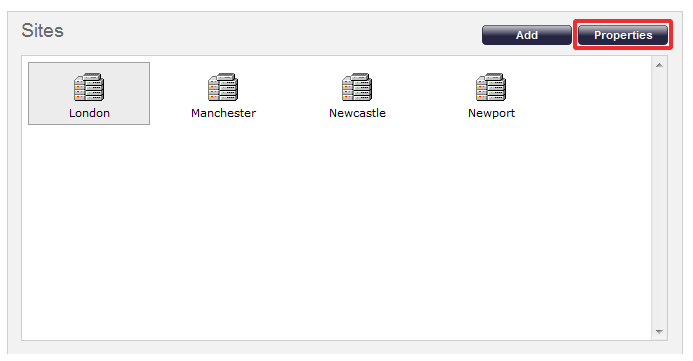
The following configuration screen will appear:

All the tabs in the above window will be explained below.
PBX
The properties displayed under the PBX tab will vary in accordance with the connection method supported by your telephone system. Please refer to the Connecting to your PBX section above for detailed information about each particular PBX model.
For some telephone system you may need to download the PBX interface file from your Download area on the Gateway. |
Please see below a description of all properties according to the connection method used:
All connection types
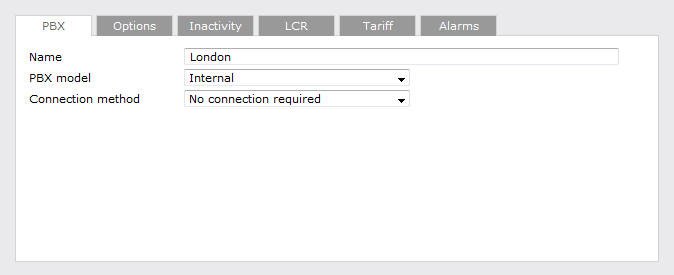
| Field | Description |
|---|---|
| Name | Simply type the name by which which you would like to identity the site. If there is just one site but more than one telephone system connected, enter the name by which you would like to identify the telephone system here. |
| PBX model | Select the PBX model from the drop-down list provided. |
| Connection method | From the drop-down list, select the connection method supported by your phone system. |
Listening Connection
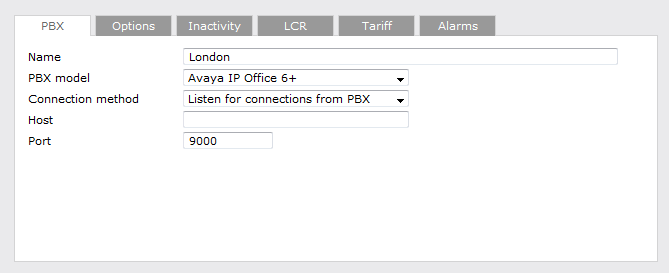
| Field | Description |
|---|---|
| Host | Leave this blank although it can be configured to restrict incoming data from a specific IP address. |
| IP address | Enter to port number used by the phone system to send the CDR data. |
Active Connection

| Field | Description |
|---|---|
| Host | Type in the IP address of the PBX system you are connecting to. |
| IP address | Enter a port number for the call logger to connect to the phone system. |
| Username | If your phone system requires authentication, enter the username here. |
| Password | If your phone system requires authentication, enter the password here. |
FTP Transfer
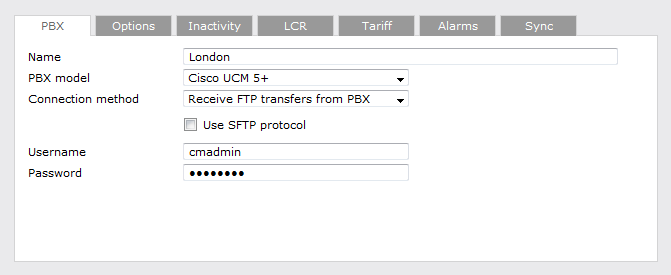
| Field | Description |
|---|---|
| Username | Enter the username created for the FTP transfer. |
| Password | Enter the password created for the FTP transfer. |
DSN Connection
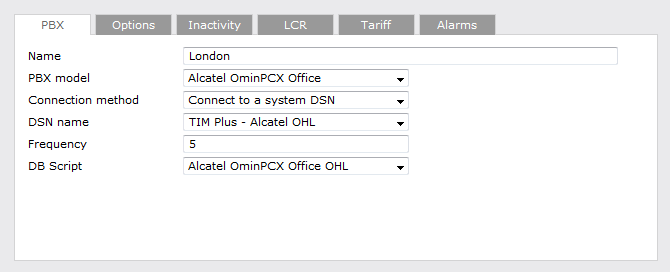
| Field | Description |
|---|---|
| DSN name | Enter the DSN name here. |
| Frequency | Enter the connection frequency here; i.e. how often it polls the DSN connection. |
| DB Script | Enter the DB script here. If you are not sure which DB script is required for your particular PBX, you can e-mail us at support@tri-line.com and we can provide the correct file. |
Radius Connection

| Field | Description |
|---|---|
| Client IP | Enter the IP address of the device that sends the RADIUS events . |
| Secret | Enter the RADIUS authentication. |
SysLog Connection
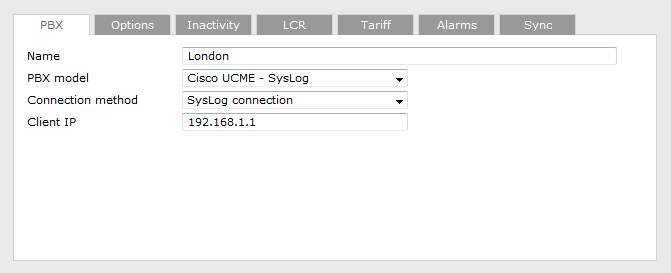
| Field | Description |
|---|---|
| Client IP | Enter the IP address of the device that sends the SYSLOG events. |
Options
The Options tab enables you to keep a local backup of data received, timestamp incoming call records and delay processing of call records. These options are explained in more detail below.
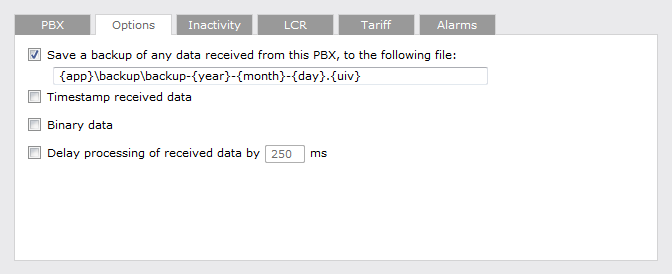
Save a backup of any data recieved from this PBX
By default, we save a backup of the data received from the PBX in case this requires to be reprocessed at a later stage (e.g. your database becomes corrupt or someone accidentally deletes calls from the system).
To save a backup of the CDR data, type the location of the folder you want to store the files; by default, the following is provided {app}\backup\backup-{year}-{month}-{day}.{uiv}. The {..} represent the system variables which are explained in more detail in the table below:
| Item | Description |
|---|---|
| app | This variable is the installation path for where TIM Plus is installed. |
| year | This will enter the year the data was captured so that it is easily recognisable later. It can be used to create sub-folders which contain this information or filenames. |
| month | This will enter the month the data was captured so that it is easily recognisable later. It can be used to create sub-folders which contain this information or filenames. |
| day | This will enter the day the data was captured so that it is easily recognisable later. It can be used to create sub-folders which contain this information or filenames. |
| uiv | The UIV represents the unique ID associated to each site. |
Timestamp received data
Some PBXs do not always output the date and time for the call records. This option allows you to timestamp all data received.
Binary data
This option is used only for PBXs that send the data in binary format (e.g. ISDX telephone system). When the Binary dataoption is ticked, we don't add a new line after each data batch we receive. This prevents data corruption.
Delay processing of received data by { }ms
This option is used when the switch/network/PC has a really slow connection and TIM Plus needs to wait x milliseconds before it attempts to process the data. This is to ensure that all data is received before processing.
Inactivity
If you are worried about losing data, then set an inactivity timer to advise when TIM isn't receiving it. You can determine how long you're prepared to wait for data e.g. 30 minutes as shown below.
You then decide who gets the alert, by filling their e-mail details as shown here. You may exclude certain time from the Inactivity timers e.g. out of hours, as you would not be expecting to receive calls anyway.
Inactivity
The Inactivity option allows you to set up an inactivity timer that notifies you when no data is being received in the call logger. You can decide upon the interval of time you want to set up the timer and also if you want to exclude specific hours or days, when you are not expecting any call activity (e.g. during the weekend).
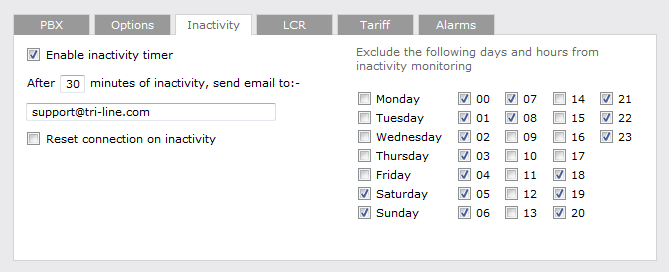
You can also decide who gets the alert, by filling their e-mail details in the box provided.
Enable inactivity timer
You can determine how long you want to wait for a call before activating the inactivity timer and who you want to send it to by simply filling in the inactivity timer fields.
Reset connection on inactivity
If this box is ticked, the system will automatically resets the connectsion to the PBX.
Exclude days and hours from inactivity monitoring
Tick the box alongside the days and hours when no call activity is expected (e.g. nights or weekends), so you don't receive an email notification for those periods.
LCR
If you use LCR (Least Cost Routing) to route calls, then you will need to add the LCR codes here so TIM Plus can identity them.
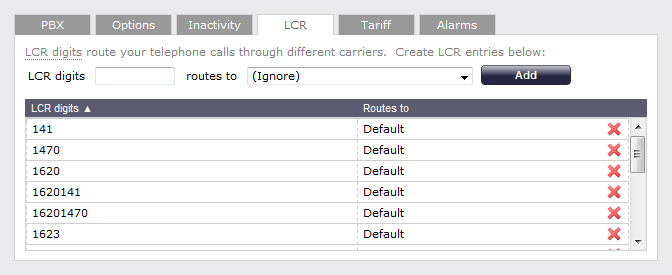
Adding LCR codes
To add an LCR code enter the number in the LCR digits field and add the route it takes in the Routes to field, as shown above.There is no limit to the number of LCR routes that can be added.
Removing LCR codes
To remove an LCR code, click on the  icon alongside the code.
icon alongside the code.
Tariff
Select the tariff table that you want to use from the list provided here. Please note that by default, TIM Plus is provided with a standard BT rate.
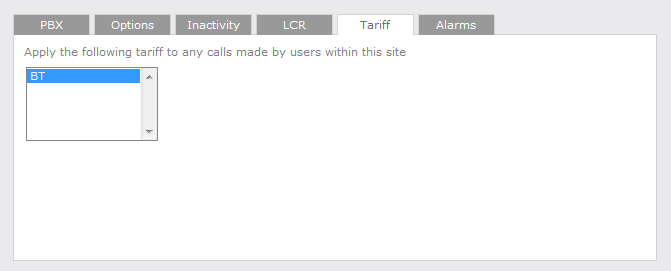
Alarms
Alarms can be set to be trigerred by specific events (e.g. when calls above a certain duration are made, when specific numbers are dialled or when defined cost-thresholds are exceeded).
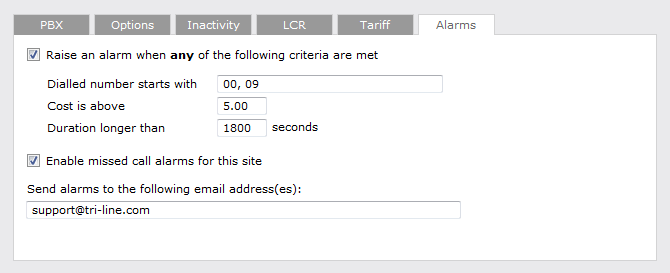
Dialled number alarm
Alarms can be set to activate when a part or full number is dialled. If you want to add a series of full or partial numbers, you can separate these entries by a comma as shown above.
Acceptable formats include: 00, 09, 020726526, 02072652600.
Cost alarm
You can trigger an alarm to be activated when a call exceeding a pre-set cost is made by anyone on this site. Note that the cost will relate to the local currency. e.g. in the example below the 5.00 would be UK£5 in UK, €5 in Europe or US$5 in USA.
Duration alarm
An alarm can be activated when a call exceeding a predetermined duration is made by anyone on this site. All durations are shown in seconds (e.g. 30 minutes = 1800 seconds).
Missed call alarm
You can be alerted if any calls are missed for the site by ticking alongside the Enable missed call alarms for this site. Then simply type in the e-mail address of the person who you would like to send notification to as shown above. You may type multiple e-mail addresses as long as you comma separate.
To configure the Site's properties, simply select it and click on the button, at the top right-hand side of the Sites panel, as shown below:

The following configuration screen will appear:

In the next pages, all the tabs of the above window are explained.